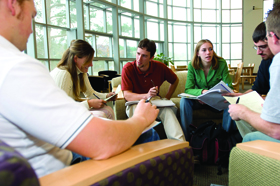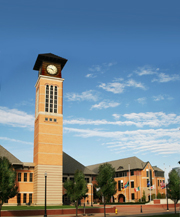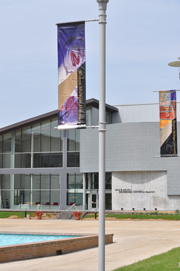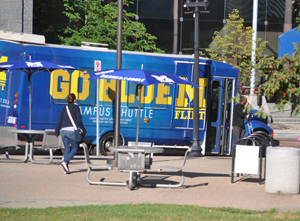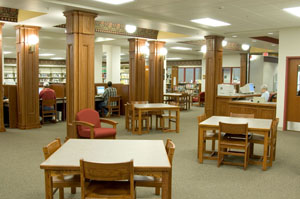Michigan State University has released a report suggesting ways to help deal with certain blighted, abandoned private property. In the report they suggest performance bonds, or something similar, that could be used to help with the tear down after certain commercial or industrial developments are no longer in use. They provide examples of other industries that use this mechanism as a way for the public to avoid bearing the cost of the end of the life cycle of these private sector developments. League CEO, Dan Gilmartin was quoted in the press release on the topic, saying this type of creative thinking is just what we need to help us solve themany issues that come with blighted abandonded parcels in our communities. The press release can be read here. The report can be found in the link below.
House Appropriations Committee Votes to Cut CDBG Funds in Half
The US House Appropriations Subcommittee on Transportation, Housing and Urban Development voted to cut Community Development Block grant (CDBG) funding to communities in half from $3.08 Billion in 2013 to $1.6 Billion in 2014. This reduction is on top of the cuts from the sequester. An amendment by Rep. Fattah (D-PA) would have restored the funding to $3.3 Billion, but was defeated along a party line vote. Please contact your Congressional Representatives and tell them how important CDBG funding is – and that communities cannot absorb a 50% reduction. For Contact information for your Congressional leaders, click here.
Summer Minnick is the Director of Policy Initiaves and Federal Affairs. She can be reached at 517-908-0301 or sminnick@mml.org.
Contact Your Congressional Representative to Move Marketplace Fairness in House
Now that the Marketplace Fairness bill, referred to also as the online sales tax parity issue, has moved to the US House of Representatives, local officials need to be contacting their Congressional Representative to urge them to move the bill. Currently, the House introduced bill, H.R. 684, is in the House Judiciary Committee. But, while the bill is not up for the full House yet, we still need to communicate with our delegation so they know how important this issue is to local communities. You can get contact information for your member of Congress here. This parity would bring hundreds of millions in lost revenue back to Michigan! Urge your Congressperson to Support the Marketplace Fairness Bill!
Summer Minnick is the Director of Policy Initiaves and Federal Affairs. She can be reached at 517-908-0301 or sminnick@mml.org.
Municipalities Implementing Bold Strategies to Sustain Vibrant Economies and Healthy Communities
Reprinted with persmission from The Review magazine
In order for Michigan cities to sustain vibrant economies and healthy communities, they must implement bold strategies that ensure more of the residents attain college degrees and valuable postsecondary certificates.
A recent study by CEOs for Cities found that 58 percent of a region’s economic health comes from the educational attainment of its residents. Another one from Georgetown University predicts that 62 percent of all Michigan jobs will require postsecondary education by the year 2018.
The benefits of increased levels of education to cities are substantial. Per capita income increases, and subsequently so do tax revenues. Unemployment goes down and so does reliance on public benefits. Crime goes down and volunteerism goes up. The demand for a more highly skilled workforce is growing—and municipal leaders have a unique opportunity to be a part of the supply-side solution.
According to the National League of Cities (NLC), municipal officials are uniquely positioned to form new partnerships with leaders in K-12 and higher education, workforce development, and business to increase postsecondary completion rates.With support from Lumina Foundation, NLC’s Institute for Youth, Education and Families has developed a new series of publications highlighting city strategies to increase local college completion rates. They have also analyzed the role that mayors are playing to support college access and success in their cities. In the last few years, municipal leaders in dozens of cities have launched new, multi-sector collaborations to dramatically increase the proportion of residents in their communities who obtain postsecondary degrees and credentials. City officials are increasingly focused on postsecondary success as a core component of their economic development strategies.
In Michigan, municipal leaders have the opportunity to leverage new resources for their communities by joining a growing coalition of networks committed to ensure more of their residents pursue and complete education beyond high school.
In 2008, a group of high-level leaders representing K-12, higher education, business, government, nonprofit organizations, and philanthropy, began meeting to discuss the possibility of establishing a statewide network responsible for galvanizing an educational attainment movement in the state.
Michigan College Access Network (MCAN) formally launched in 2010 with support from federal, state, and philanthropic funding and was charged with increasing Michigan’s educational attainment rate to 60 percent by the year 2025. Only about 36 percent of Michigan adults aged 25-64 possess at least an associate degree (to find your county’s rate, visit www.luminafoundation.org/state/Michigan/).Local College Access Networks
Just three years later, MCAN is now supporting more than 50 communities’ efforts to mobilize leadership and resources around the goal of increasing the educational attainment of their citizens with a focus on aligning systems around college readiness, college participation, and college completion rates. Far too many Michigan students don’t pursue higher education after high school—and many that do, don’t ever complete a degree because they aren’t socially, academically, informationally, or financially prepared. MCAN helps communities build cross-sector strategic alliances, known as Local College Access Networks, or LCANs.
Each LCAN:
• Agrees on a vision;
• Establishes clear college readiness/
participation/completion goals;
• Aligns and coordinates existing organizations to shared goals to fill differentiated roles;
• Implements a collaborative action plan based on data-driven community priorities; and
• Tracks progress on goals transparently and holds partners accountable for results.
Communities throughout Michigan are designing and implementing innovative strategies to boost college attainment via their LCANs. In Newaygo County, community leaders have raised enough funds to place full-time college advisers in each of their high schools to provide one-on-one assistance guidance to all graduating seniors. Benton Harbor, Hazel Park, Lansing, Pontiac, and Saginaw have all launched universal place-based scholarships to all students inspired by the Kalamazoo Promise. Muskegon County and St. Clair County are each leading major public awareness campaigns to build a college-going culture.
Bay City and Jackson both opened college access resource centers where students and families can visit to get advice and resources on postsecondary educational opportunities. Escanaba has identified former students who are not enrolled in college but are within 12 credits from an associate degree and supports them to complete the degree. Sturgis recently launched a 10-year strategic plan for the city and has lifted up their LCAN as their primary workforce development strategy. Detroit and Grand Rapids are both participating in a national competition to demonstrate the largest increase in postsecondary completion—the winner will get a $1 million prize to launch a national promotional campaign highlighting local efforts.
Steps Municipal Leaders Can TakeIn their recent respective publications, both MCAN and NLC have outlined a set of action steps for municipal leaders who are concerned about low college completion rates and want to identify and advance solutions. As a first step, local officials can convene leaders from across sectors to develop a more coordinated strategy to provide students will supports and services they need to graduate with a postsecondary credential.
Additional action steps mayors/presidents should take include:
• Conducting an inventory or scan of local college access and success efforts across sectors, institutions, and community partners;
• Hosting consultative sessions to listen to the perspectives of various stakeholders;
• Establishing a leadership structure to guide and sustain college access and completion efforts;
• Seeking consensus regarding measurable outcomes and key benchmarks or milestones to assess progress;
• Creating data sharing agreements and protocols in order to assemble a fuller picture of the municipality’s education pipeline;
• Developing and implementing action plans that have the potential to “move the needle” on college completion; and
• Persistently raising awareness and celebrating early victories to build and sustain momentum.
To read more about the NLC Postsecondary Success Action Guides, go here.
For Michigan municipal leaders, MCAN can provide grant funding, hands-on technical assistance, and additional tools to interested funding. For more information, visit www.micollegeaccess.org.
Brandy Johnson is the executive director of the Michigan College Access Network. You may reach her at 517-454-1387 or brandy@micollegeaccess.org. Marjorie D. Cohen is a senior associate at the National League of Cities Institute for Youth, Education and Families. You may reach her at 202-626-3052 or cohen@nlc.org.
Michigan Legislature Adjourns With No Transportation Funding Vote Taken
Last week the legislature adjourned until September. There are a few tentative days scheduled in July and August but, as of now, there will be no voting and no attendance taken on those days. The legislature broke without voting on anything regarding future transportation funding. This will continue to be a hot topic for the fall when they return to full session.
One other issue left hanging for the summer is Medicaid expansion. The House passed Medicaid expansion two weeks ago giving the Senate one week to pass it themselves. Coming down to the final day of session before the summer recess, the Senate adjourned last Thursday without taking a vote. Senate Majority Leader Randy Richardville has stated he wants at least half of the Republican caucus to vote for the package. Governor Snyder cut an overseas business trip short and flew back on Thursday to try and help shore up the votes but no vote was ever taken. He has publicly expressed his disappointment with a no vote action and is making his rounds across the state to some key republican districts in order to get citizens to engage in persuading their legislator to vote for the expansion. This will likely be a hot topic going through the summer and into the fall if they can’t get it done this summer.
Nikki Brown is a legislative associate for the League. She can be reached at nbrown@mml.org or 517-908-0305.
Quality of life for All
Since beginning work at the MML some 8 years ago, I have always marked the official start of summer by the annual trip to visit members in the Upper Peninsula through our Region 7 meeting. Always an anticipated event not just because of the opportunity to enjoy the beauty of the UP and the hospitality of local officials in the region, but also because it means a road trip with colleagues and an opportunity to relive such events of years gone by.
This year was no different as we rolled our way across the bridge to Bessemer in the far western UP. Ten hours in a car with family, let alone co-workers, is a challenge at any point in time, but this year was made easier by the outstanding weather, scenery and of course the company.
And as is the case with any of the League’s meetings, there was a lot of listening and learning from each other and presenters. I was even given the opportunity to present on the League’s place-based strategies with a focus on the MIPlace Partnership Initiative. However, what I hoped would be an uplifting session was in the end as challenging as any I’ve given, having forgotten the golden rule of presentations…know thy audience.
It hit me during the question and answers session. A councilman spoke to thank me for the session, since it made clear for him that he did not want his community becoming anything like those I had spoken of. Having lived in larger communities downstate, he was now very satisfied being in a small town that offered amenities more in tune with a family lifestyle than with that of attracting a young and talented workforce.
As we talked, I noted that at the end of the day it is up to the local community and its leaders to figure out who they are and what they want to be. And as I thought about our discussion later and talked with colleagues, I realized that what I should have been focusing on was the larger picture of what it means in 21st century terms for local officials to provide a high “quality of life”.
You see, my presentation focused on the latest demographics and market research showing the groups prevalent today and what they’re looking for in a community. And while that is all well and good, what got lost in translation is the fact that the amenities the two largest groups in society today (young people and empty nest baby boomers) are looking for relate back to quality of life not just for them but for all of us.
Attributes such as walkable downtowns and neighborhoods, quality public spaces such as parks, different housing options including mixed-use commercial residential in our downtowns, and transportation options like bike lanes are all part of a broader package of qualities that work to make a community vibrant and resilient, whether you are looking to attract young professionals, families, retirees or all three groups.
This has always been the point of the League’s emphasis on “place” and we are finding it to be true time and again as we uncover successes across the state in communities big and small, urban, rural and suburban. If nothing else, our trip not only again confirmed how geographically large and diverse our state is, it also confirmed that each and every community across the state has something to offer toward providing a high quality of life for residents and visitors alike.
Bill to Allow Use of Signature Stamp on Election Documents Passes House
Legislation sponsored by Rep. Andy Schor, HB 4478, passed the full house on Thursday that would allow a person who is unable to write or who cannot sign a signature due to a physical disability to use a signature stamp on election documents (voter applications, absentee ballots, absentee envelopes, etc). Currently, the law states that individuals who cannot write are allowed to make their mark. This legislation adds in the ability to use a signature stamp (a preservation of their signature from in the past) instead of a “mark” and defines physical disability.
The League is supportive of this legislation.
Nikki Brown is a legislative associate for the League. She can be reached at nbrown@mml.org or 517-908-0305.
ORV Legislation Another Step Closer to the Governor’s Desk
This week the the Senate Committee on Natural Resources, Environment and Great Lakes moved three bills designed to help expand ORV use in Michigan for residents and tourists.
Senate Bill 50 would allow the DNR to create free ORV riding days. These would be similar to the free fishing weekends currently established by the DNR and would allow riders to use Michigan’s trail system without purchasing a license.
House Bill 4284 would establish a process for local units of government to approach MDOT with a request allowing ORV use on State Trunklines within their jurisdiction. It would also allow MDOT to designate State Trunklines for ORV use for the purpose of connecting trails or for access to food, fuel ,or lodging.
House Bill 4299 would expand the ability of a local unit of government to pass an ordinance allowing or preventing ORVs on roadways under their jurisdiction to all 83 counties.
Through discussion with the sponsors of these bills the League has worked to improve our communities local control over ORVs while maintaining high safety standards for riders, increasing access to trails and promoting tourism in Michigan.
John LaMacchia is a Legislative Associate for the League handling Transportation issues. He can be reached at jlamacchia@mml.org or 517-908-0303.
Representative Lauwers and Representative Callton to Host Transportation Town Halls
Please mark you calendars and spread the word about more transportation towns halls coming up this month.
- Representative Dan Lauwers, Tuesday June 25th, 6:00 p.m. to 7:30 p.m., Location: St. Clair County RESA, Woodward Development Center Cafeteria, 499 Range Road Marysville, MI 48040
- Representative Mike Callton, Tuesday June 25th, 6:00 p.m. to 8:00 p.m., Location: Ionia County Commission on Aging, 115 Hudson St., Ionia, MI 48846
We encourage you to attend these town halls and help spread the League’s message about funding a complete transportation system that is built to support all users.
John LaMacchia is a Legislative Associate for the League handling transportation issues. He can be reached at jlamacchia@mml.org or 517-908-0303.
Timeliness Report for Bridge Safety Inspections for Local Agencies Released by MDOT
MDOT has released the timeliness report for bridge safety inspections for local agencies. A copy of the report can be found below.
John LaMacchia is a Legislative Associate for the League handling Transportation issue. he can be reached at jlamacchia@mml.org or 517-908-0303.


